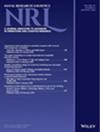A model of supply‐chain decisions for resource sharing with an application to ventilator allocation to combat COVID‐19
IF 2.1
4区 管理学
Q3 OPERATIONS RESEARCH & MANAGEMENT SCIENCE
引用次数: 118
Abstract
We present a stochastic optimization model for allocating and sharing a critical resource in the case of a pandemic. The demand for different entities peaks at different times, and an initial inventory for a central agency are to be allocated. The entities (states) may share the critical resource with a different state under a risk‐averse condition. The model is applied to study the allocation of ventilator inventory in the COVID‐19 pandemic by FEMA to different U.S. states. Findings suggest that if less than 60% of the ventilator inventory is available for non‐COVID‐19 patients, FEMA's stockpile of 20 000 ventilators (as of March 23, 2020) would be nearly adequate to meet the projected needs in slightly above average demand scenarios. However, when more than 75% of the available ventilator inventory must be reserved for non‐COVID‐19 patients, various degrees of shortfall are expected. In a severe case, where the demand is concentrated in the top‐most quartile of the forecast confidence interval and states are not willing to share their stockpile of ventilators, the total shortfall over the planning horizon (until May 31, 2020) is about 232 000 ventilator days, with a peak shortfall of 17 200 ventilators on April 19, 2020. Results are also reported for a worst‐case where the demand is at the upper limit of the 95% confidence interval. An important finding of this study is that a central agency (FEMA) can act as a coordinator for sharing critical resources that are in short supply over time to add efficiency in the system. Moreover, through properly managing risk‐aversion of different entities (states) additional efficiency can be gained. An additional implication is that ramping up production early in the planning cycle allows to reduce shortfall significantly. An optimal timing of this production ramp‐up consideration can be based on a cost‐benefit analysis.资源共享的供应链决策模型及其在抗击新冠肺炎呼吸机分配中的应用
我们提出了一个在大流行情况下分配和共享关键资源的随机优化模型。不同实体的需求在不同时间达到峰值,中央机构的初始库存将被分配。在规避风险的条件下,实体(州)可能与不同的州共享关键资源。该模型被应用于研究FEMA在新冠肺炎疫情中向美国不同州分配呼吸机库存的情况。研究结果表明,如果非COVID-19患者的呼吸机库存不足60%,FEMA的库存为20 000台呼吸机(截至2020年3月23日)将几乎足以满足略高于平均需求情况下的预计需求。然而,当75%以上的可用呼吸机库存必须留给非新冠肺炎患者时,预计会出现不同程度的短缺。在严重的情况下,需求集中在预测置信区间的最上四分之一,各州不愿意分享其呼吸机库存,在规划期内(直到2020年5月31日)的总短缺约为232 000个呼吸机日,峰值短缺17个 2020年4月19日,200台呼吸机。还报告了需求处于95%置信区间上限的最坏情况的结果。这项研究的一个重要发现是,中央机构(FEMA)可以作为协调员,共享随着时间的推移而短缺的关键资源,以提高系统的效率。此外,通过适当管理不同实体(州)的风险规避,可以获得额外的效率。另一个含义是,在规划周期的早期提高产量可以显著减少短缺。这种生产增加考虑的最佳时机可以基于成本效益分析。
本文章由计算机程序翻译,如有差异,请以英文原文为准。
求助全文
约1分钟内获得全文
求助全文
来源期刊

Naval Research Logistics
管理科学-运筹学与管理科学
CiteScore
4.20
自引率
4.30%
发文量
47
审稿时长
8 months
期刊介绍:
Submissions that are most appropriate for NRL are papers addressing modeling and analysis of problems motivated by real-world applications; major methodological advances in operations research and applied statistics; and expository or survey pieces of lasting value. Areas represented include (but are not limited to) probability, statistics, simulation, optimization, game theory, quality, scheduling, reliability, maintenance, supply chain, decision analysis, and combat models. Special issues devoted to a single topic are published occasionally, and proposals for special issues are welcomed by the Editorial Board.
 求助内容:
求助内容: 应助结果提醒方式:
应助结果提醒方式:


